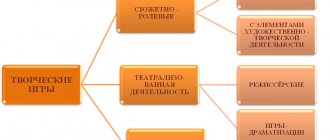The role of the teacher in the formation of play activities of preschool children
The role of the teacher in the formation of play activities of preschool children
Independent play activity of preschool children is impossible without the guiding influence of an adult, a teacher. But at the same time, the teacher only creates the conditions for starting the game, and does not dictate to the students what to do. Among the conditions are:
selection and proposal of the game itself, taking into account the age and individual characteristics of children;
establishing dialogical relationships with children, the ability to hear their requests, support children’s initiative;
encouragement for creativity, creation of unexpected situations;
organization of adequate subject-spatial conditions;
the teacher’s ability to play, his emotional involvement, which stimulates the interest and initiative of the pupils.
Despite the fact that the game is an independent activity of children and does not boil down to the acquisition of any skills, does not require standard methods of action, and that is, does not require a special training process, it is nevertheless necessary to teach the game. Learning is carried out in joint play with an adult who involves children in play activities.
Numerous studies and observations show that children's play does not arise on its own, without the participation of those who already know how to play - adults or older children. Children with whom no one has ever played cannot invent game substitutions themselves, enter into a role, or act out a game situation. This means that an adult, a teacher, should play with children, becoming a partner, a participant in the game. But the teacher does not need to control the actions of students or evaluate the quality of the game. Children should not feel pressure and guidance from an adult, but treat him with respect, as a partner who knows how to play.
The teacher needs to take the game seriously, demonstrating interest, passion, and emotionality. This is a guarantee of involvement
pupils into the game. Involving children in the game, helping its development, the teacher not only plays at the children’s level, but must somewhat outstrip the children’s gaming capabilities, involve them in the gaming process of a higher level and open up new opportunities for children, that is, set the zone of proximal development of the game. Thus, at 2-3 years old, children, together with an adult, discover the possibilities of renaming objects and playing substitutions. At 3-4 years old, children need to be shown the possibilities of taking on a play role and role-playing dialogue. At the same age, games with rules can be introduced. After 5 years, children become involved in fantasy games. The teacher’s task at each stage and in each type of game is to orient the child towards his peers, since the game is a common joint activity of children and in it it is necessary to take into account the actions of the partners, to hear and see those playing nearby. These valuable abilities are best developed through play activities. The role of the teacher in the process of introducing children to the game is to unite the students around the game.
The teacher’s skill is most clearly demonstrated in organizing children’s independent activities. How to direct each child to useful and interesting play without suppressing his activity and initiative? How to alternate games and distribute children in a group room or area so that they can play comfortably without disturbing each other? How to eliminate misunderstandings and conflicts that arise between them? The comprehensive upbringing of children and the creative development of each child depend on the ability to quickly resolve these issues.
The main activity of preschool children is role-playing game, which has an extensive character, where several tasks are connected with a single meaning. In role-playing games, the teacher, in joint activities with the children, teaches children play actions: how to feed a doll or a bear, rock them, put them to bed, etc. If a child finds it difficult to reproduce a play action, the teacher uses the technique of playing together.
For games, simple plots with 1-2 characters and basic actions are selected: the driver loads the car with cubes and drives it; Mom rolls her daughter in a stroller, feeds her, puts her to bed. Gradually, the first game plans appear: “Let’s go to the store, buy something tasty, and then there will be a holiday.” The teacher solves game problems together with all participants in the game (building a house, playing family).
Through play, children’s interest in various professions is consolidated and deepened, and respect for work is fostered.
Young children begin to play without thinking about the purpose of the game and its content. Drama games are very helpful here . They help expand children's ideas and enrich the content of the child's independent play.
Children willingly accept substitute objects for play. Game items imitate real ones. This helps to understand the meaning of the game situation and inclusion in it. In further joint games with children, the teacher expands the range of actions with substitute objects. For example, in one game situation the stick is a spoon, in another the same stick is a thermometer, in a third it is a comb, etc.
In the group, it is necessary to preserve the object-play environment, specially organize it, and select the same toys that were used in joint play. Gradually, along with substitute objects, imaginary objects are also introduced into the game (comb your hair with a comb that is not there; treat you to candy that is not there; cut a watermelon that is not there, etc.).
If the child introduces all this into a game situation on his own, then he has already mastered the basic game skills of a story game.
Playing with dolls is the main game of a preschool child. The doll acts as a substitute for an ideal friend who understands everything and remembers no evil. A doll is both an object for communication and a play partner. She doesn't get offended and doesn't stop playing.
Games with dolls allow children to understand the rules of behavior, develop speech, thinking, imagination, and creativity. In these games, children show independence, initiative and creativity. While playing with a doll, a child develops, learns to get along with other people, and live in a group.
Playing with dolls as daughters and mothers has existed at all times. This is natural: the family gives the child his first impressions of the life around him. Parents are the closest, beloved people whom, first of all, you want to imitate. Play, the most important type of children’s activity, plays a huge role in the development and upbringing of a child. It is an effective means of shaping the personality of a preschooler, his moral and volitional qualities; the game realizes the need to influence the world. Soviet teacher V.A. Sukhomlinsky emphasized that “game is a huge bright window through which a life-giving stream of ideas and concepts about the world around us flows into the child’s spiritual world. Play is the spark that ignites the flame of inquisitiveness and curiosity.”
The role of the teacher in the play process of children of primary preschool age
The success of any person depends on how he knows how to perform certain social roles. Already at a very early age, when entering society, a child is forced to fulfill these roles. Play as the main activity of a preschool child helps him to master various social roles: the role of a partner, initiator, etc. An important task of the teacher is to teach the child this, since he will then have to master more complex roles. This article is devoted to this problem.
Key words: game, society, children of primary preschool age, teacher, team.
Play, being an important part of a child’s life, is a reflection of the life of the society in which an individual child lives.
A gaming group is a social “organism” with its own relationships: cooperation, subordination, mutual control. The teacher, being the immediate leader of children's games, develops in them certain skills for living in a team: the ability to play together on the basis of mutual understanding, to help each other.
Initially, all children have equal rights to roles in the game, but at the same time, at any moment, each of them can come up with and offer something of their own, propose their own development of the game, and also resolve controversial issues.
Thus, the first traditions, their own “public opinion” are already beginning to emerge in the team, which will further determine the actions of children, regulate the relationships between them, and serve as a “measure” for assessing their own behavior, as well as the behavior of others.
Already at a very early age, children develop a need for communication. From the first months of life, a child, with his smile, various sounds he makes, and movements of his hands, expresses the joy of communicating with adults, who in their time are his first partners. At the same time, adults teach the child to recognize the world around him, to distinguish its sounds, smells, colors, etc. And already at a very early age, selective play actions can be observed in children. One will happily rattle rattles with images of birds and animals, while the other will choose simple spoons for himself and will also be happy making sounds from them. And from the moment the baby begins to crawl and sit, his play capabilities expand. He develops an interest in objects that develop his movements.
Adults, guiding children’s games, help them develop the plot of the game and be able to complete game actions. The teacher's sincere interest in the game, an affectionate tone, and a caring attitude towards the child and the image created in the game cultivate sensitivity and responsiveness in children.
In joint play with an adult, the child learns to invent a game, perform the necessary game actions, use not only the toys themselves, but also their substitutes, and learn to complete the game. It is important that children enjoy the game and bring them joy. If the child already knows how to play alone for a relatively long time (5–10 minutes), the teacher can direct his attention to a peer playing nearby, trying to arouse interest in his play.
At first, the baby becomes interested in the toy in the hands of a neighbor and will certainly want to get it. At this moment, contradictions may arise between children, which the teacher has the right and must resolve. Knowing the individual characteristics of each child, the teacher should try to engage them in joint play activities with one toy, or switch attention to playing with other objects. Sometimes it is advisable to develop the activity of one child and somewhat slow down the actions of another.
By playing certain roles, the child imitates not only the actions of an adult, but also his attitude towards toys and other participants in the game. The teacher’s passion for the role in the game and his sincerity contribute to the manifestation of the child’s own feelings. Children, due to a lack of knowledge, skills and abilities, have an unstable interest in the game. In this case, the role of the teacher is to support children’s interest in a certain role, give children the necessary knowledge to develop the plot of the game, as well as teach them certain skills and prompt them to perform the necessary actions.
The involvement of children in joint games should take place gradually with great caution, and in no case should it interfere with the desire of the child himself. Sociable children will be the very first participants in the games. And children who are more withdrawn will initially become only observers. And this should not be assessed in any way by the teacher. Otherwise, the latter may lose interest in group games for a long time, and then the child’s stay in kindergarten will turn into only a test.
It is important to take into account the characteristics of children of primary preschool age and organize games in small groups. In such games, the child can more clearly express himself as a partner in the game, which in the future will serve as the basis for mutual understanding and trust in his peers. A child who knows how to independently invent and develop a plot can easily be interested in the play of another.
Compliance with behavioral norms also depends on the child’s internal motivation, on what feelings he experiences and what feelings his partners in the game experience towards him. In a small play group, where the basis is mostly personal sympathy, it is easier for children to build friendly relationships and observe the norms of collective behavior.
For the development of collective creativity and the ability to analyze one’s actions, the skill of summing up a game is important. A technique such as talking with children at the end of the game can come to the rescue. Such conversations contribute to the development of thinking not only independently, but also with a perspective for the future. During the conversation, the teacher teaches children to evaluate their actions with dignity, analyze the actions of other characters in the game, and reflect on why the game ended this way and what can be changed next time.
Children gradually accumulate certain knowledge about the things and phenomena around them, about household items, and about the work of adults. They are interested not only in the actions of the people around them, but also in their experiences, concerns, and relationships. The accumulated knowledge allows us to expand the themes of games, and role-playing games appear. However, at this age, children’s interest in the plot is still unstable, and they easily move from one game to another. Consequently, in early preschool age, children can play joint games only if the organizing and guiding role of the adult is preserved.
Literature:
- Vygotsky L. S. Play and its role in the mental development of a child / L. S. Vygotsky // Questions of psychology. - 1966. - No. 06. - P. 62–68.
- Zaporozhets A.V. Game and child development / A.V. Zaporozhets // Preschool education. - 1964. - No. 4.
- Novoselova S. L., Zvorygina E. V. Play and comprehensive education of children / S. L. Novoselova, E. V. Zvorygina // Preschool education. - 1983. - No. 10 p. 38–46.
- Federal State Educational Standard of Preschool Education: first results: [Text]: materials of the interregional scientific and practical conference / ed. general ed. E. V. Kotochigova - Yaroslavl: GOU YaO IRO, 2015. - 72 p.







